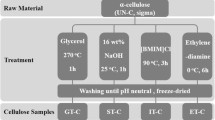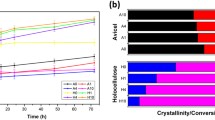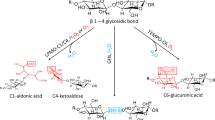Abstract
Crystalline cellulose Iβ (Avicel) was chemically transformed into cellulose II and IIII producing allomorphs with similar crystallinity indices (ATR-IR and XRD derived). Saccharifications by commercial cellulases at arrayed solids loadings showed cellulose IIII was more readily hydrolysable and less susceptible to increased dry solids levels than cellulose Iβ and II. Analysis by dynamic vapor sorption revealed cellulose II has a distinctively higher absorptive capacity than cellulose I and IIII. When equally hydrated (g water/g cellulose), low-field nuclear magnetic resonance (LF-NMR) relaxometry showed that cellulose II, on average, most constrained water while cellulase IIII left the most free water. LF-NMR spin–spin relaxation time distribution profiles representing distinct water pools suggest cellulose IIII had the most restricted pool and changes in water distribution during enzymatic saccharification were most dramatic with respect to cellulose IIII compared to celluloses Iβ and II.





Similar content being viewed by others
References
Atalla RH (1974) Annealing and increased order in cellulose II. Polym Sci Polym Lett 12:565–568
Barnes RJ, Dhanoa MS, Lister SJ (1989) Standard normal variate transformation and de-trending of near-infrared diffuse reflectance spectra. Appl Spectrosc 43(5):772–777
Chundawat SPS, Bellesia G, Uppugundla N, Sousa LC, Gao D, Cheh AM, Agarwal UP, Bianchetti CM, Phillips GM, Langan P, Balan V, Gnanakaran S, Dale BE (2011) Restructuring the crystalline cellulose hydrogen bond network enhances its depolymerization rate. J Am Chem Soc 133:11163–11174
Felby C, Thygesen LG, Kristensen JB, Jorgensen H, Elder T (2008) Cellulose-water interactions during enzymatic hydrolysis as studied by time domain NMR. Cellulose 15(5):703–710
Hodge DB, Karim NM, Schell DJ, McMillan JD (2008) Soluble and insoluble solids contributions to high-solids enzymatic hydrolysis of lignocellulose. Biores Technol 99:8940–8948
Igarashi K, Wada M, Samejima M (2007) Activation of crystalline cellulose to cellulose IIII results in efficient hydrolysis by cellobiohydrolase. FEBS J 274:1785–1792
Jørgensen H, Vibe-Pedersen J, Larsen J, Felby C (2007) Liquefaction of lignocellulose at high-solids concentrations. Biotechnol Bioeng 96:862–870
Matthews JF, Skopec CE, Mason PE, Zuccato P, Torget RW, Sugiyama J, Himmel ME, Brady JW (2006) Computer simulation studies of microcrystalline cellulose Ib. Carbohydrate Res 341:138–152
Mittal A, Katahira R, Himmel ME, Johnson DK (2011) Effects of alkaline or liquid-ammonia treatment on crystalline cellulose: Changes in morphology, crystallinity index, and enzymatic digestibility. Biotechnol Biofuels 4(41):1–16
Park S, Johnson DK, Ishizawa CI, Parillan PA, Davis MF (2009) Measuring the crystallinity index of cellulose by solid state 13C nuclear magnetic resonance. Cellulose 16:641–647
Park S, Baker JO, Himmel ME, Johnson DK (2010) Cellulose crystallinity index: measurement techniques and their impact on interpreting cellulase performance. Biotechnol Biofuels 3(10):1–11
Provencher SW (1982) Contin: a general purpose constrained regularization program for inverting noisy linear algebraic and integral equations. Comput Phys Commun 27:229–242
Roberts KM, Lavenson DM, Tozzi EJ, McCarthy MJ, Jeoh T (2011) The effects of water interactions in cellulose suspensions on mass transfer and saccharification efficiency at high solids loadings. Cellulose 18:759–773
Selig MJ, Hsieh CC, Thygesen L, Himmel ME, Felby C, Decker SR (2012) Considering water availability and the effect of solute concentration on high solids saccharification of lignocellulosic biomass. Biotechnol Prog 28(6):1478–1490
Acknowledgments
We would like to thank Peter Westh and the laboratory at the University of Roskilde for their instruction and permission to use their DVS system.
Author information
Authors and Affiliations
Corresponding author
Rights and permissions
About this article
Cite this article
Selig, M.J., Thygesen, L.G., Johnson, D.K. et al. Hydration and saccharification of cellulose Iβ, II and IIII at increasing dry solids loadings. Biotechnol Lett 35, 1599–1607 (2013). https://doi.org/10.1007/s10529-013-1258-7
Received:
Accepted:
Published:
Issue Date:
DOI: https://doi.org/10.1007/s10529-013-1258-7




